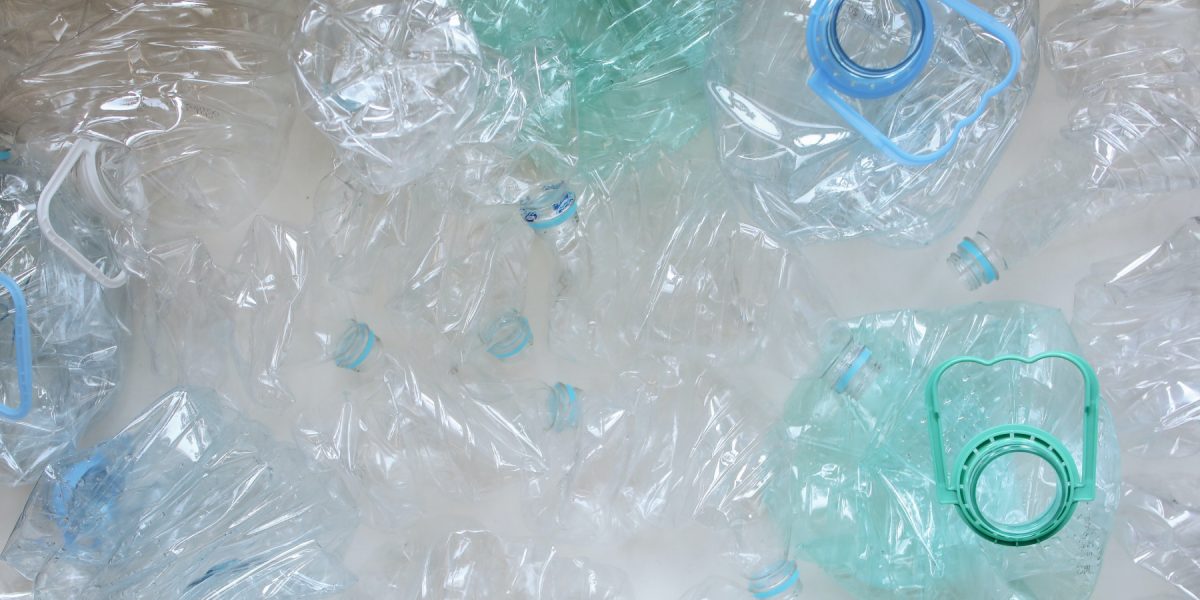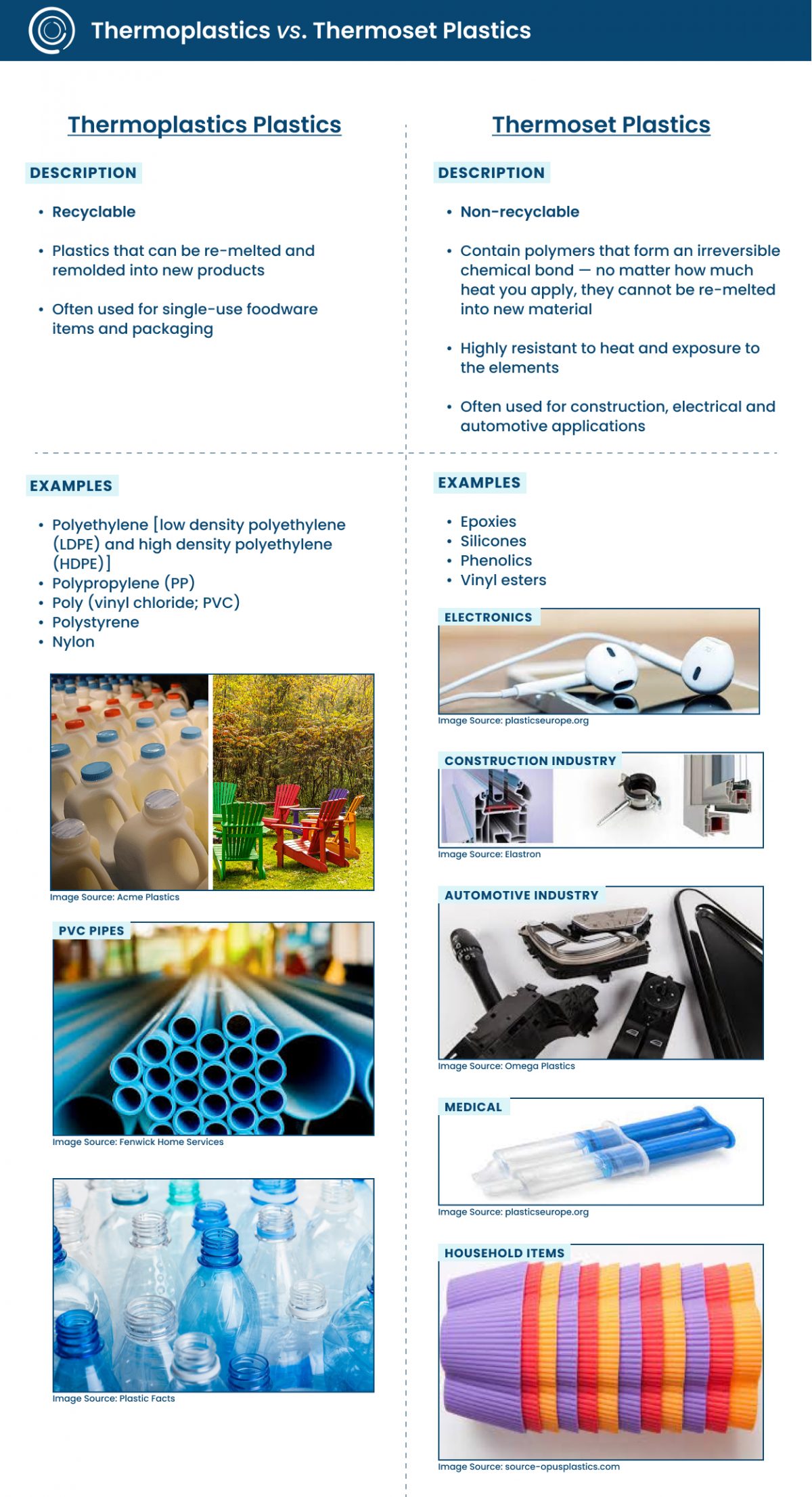Plastic

Plastic Recycling
Plastic recycling is far from a complete solution as this section will highlight. Plastic cannot be infinitely recycled and there are significant limitations to the current ability to effectively recover and repurpose recycled plastic materials. Learn the limitations of plastic recycling, and if you cannot avoid it, make sure you are responsibly recycling.
Learn the plastic recycling numbers:
Each piece of plastic has a number (standard identification codes) that range from 1 to 7 and are displayed on the underside of plastics inside a recycling triangle. Each number indicates different types of plastic with different recycling rates and effects on our health. Numbers 1 and 2 are most commonly recyclable. Check with your specific waste hauler and municipality to learn what is recyclable for your business or home.
Did-You-Know:
There are 2 types of plastics: thermoplastics vs. thermoset plastics.
Thermoplastics are plastics that can be re-melted and remolded into new products, and therefore, recycled. Thermoplastics are often used for single-use foodware items and packaging.
Thermoset plastics contain polymers that form an irreversible chemical bond – thus no matter how much heat you apply, they cannot be remelted into new material and hence, are non-recyclable. Because of the strength of their structure, thermoset plastics are more resistant to heat and exposure to the elements, so are often used for construction, electrical and automotive applications.

There are many prevalent misconceptions on the effectiveness of plastic recycling:
Only a fraction of plastic produced is recycled.
Plastic recycling infrastructure is limited in comparison to the global demand, so only a fraction of the plastic separated in recycling bins actually gets recycled. When recycling facilities are at capacity, they turn away materials to be treated in landfills or incinerators.
Plastics cannot be infinitely recycled!
Unlike metal or glass, plastic degrades with every life cycle and cannot be infinitely recycled! PET, like water bottles and soda bottles, often requires the addition of virgin plastic to achieve the rigid structural integrity of the bottle.
Food contamination is an issue.
Food contamination can cause major problems for recycling because recycling facilities will often reject items with food residue. You cannot recycle dirty plastic – any plastic material with food residues on (or in) it CANNOT be recycled. Ensure you wash your plastics before disposing of them.
Compostable plastics contaminate recycling!
Most compostable plastics are not accepted at recycling facilities and will contaminate recycling streams. They cannot be melted down and combined with other recyclable plastics as they would compromise any products created, and therefore need to be removed. Read more in our Blue Guide: Greenwashing.
Black plastic cannot be recycled.
Black plastic (commonly used for take-out and microwave meal containers) primarily cannot be recycled because it is not detected by most sorting machines!
Deep Dive: Multi-Layer Plastic (MLP)
MLP is any packaging material with at least one layer of plastic combined with one or more layers of other materials (paper, aluminum, etc.). MLPs are widely used in the food industry, due to their good storage properties, allowing a longer shelf life. However, because MLPs are composed of different material types, they require specialized infrastructure to separate the materials for recovery. The appropriate waste infrastructure is not widely available, so MLPs are often sent to landfills or incinerators.
Coffee cups are lined with a thin film of polypropylene plastic that would contaminate a paper recycling stream, and typically cannot be recycled. Keep in mind that developments to both materials and infrastructure are underway, this is a changing landscape. Read the labels on your cup and check recycling bin signage to confirm if coffee cups are recyclable in each case.
Paper cartons or Tetra Pak options are some of the most prevalent alternatives to plastic water bottles on the market. These are composed of multiple layers of plastic, wax, paper and/or aluminum and can only be recycled in specialized facilities designed to separate the different layers of material. The infrastructure to properly recycle these materials is not widely available and normally requires designated collection pickups.
The Cost of Plastic
Plastic is made from fossil fuels and all associated social and environmental harms from extracting and processing oil and gas are perpetuated by the production of plastic. Air and water pollution are created in the extraction of oil and gas whether that is through drilling on land, the deep sea or arctic drilling, or fracking. In petrochemical facilities oil and gas is then transformed into plastics releasing harmful pollution to both air and local waterways in the process, threatening the health of both workers and surrounding communities. These facilities are disproportionately located in low-income communities and affect the most vulnerable. “Cancer alley” in Louisiana earned its name for the above-average rates of cancer caused by densely located polluting industries, including many petrochemical facilities. The environmental toll of creating plastics is an environmental justice issue.
Success Story:
Led by Sharon Lavigne, 2021’s Goldman Environmental Prize winner, Rise St. James galvanized community opposition and successfully defeated the construction of a $1.25 billion plastics manufacturing plant in 2019. The group is currently fighting to prevent Formosa Plastics from building a massive multibillion-dollar plastics plant in the parish neighborhood of Louisiana. https://www.risestjames.org/
As the world transitions towards renewable energy sources, oil and gas companies are pivoting to increase their petrochemical production. Today, petrochemicals including plastic accounts for 14% of oil usage and are expected to drive half of oil demand growth leading up to 2050 (IEA). Plastic production is expected to double over the next 20 years (WEF).
Already, 11 million metric tons of plastic enters our ocean every year, which is nearly two garbage truckloads every minute! As of 2015, approximately 6300 Mt of plastic waste had been generated, around only 9% of which had been recycled, 12% was incinerated, and 79% was accumulated in landfills or the natural environment. If current production and waste management trends continue, roughly 12,000 Mt of plastic waste will be in landfills or in the natural environment by 2050 (R.Geyer et al. 2017).
Summary:
Plastic causes significant social and environmental harms throughout its lifecycle, from the point of oil and gas extraction through to the point of disposal. Currently, plastic recycling and using recycled plastic materials is an incomplete solution with many infrastructure failures. To address our plastic pollution crisis, reduction and replacement strategies need to be prioritized with recycling as a last resort. While elimination is the best solution, plastic packaging continues to be ubiquitous. For the plastic you are not yet able to eliminate, be sure to wash, sort and properly dispose of it to increase the chances for recovery.
Tips:
Wash out food containers before recycling!
Check the numbers on your plastic items and confirm that your recycling program can accept them. #1, #2, #5 are most commonly accepted.
When in doubt: rigid plastics like water bottles and food containers are recyclable, and flexible plastics like thin film packaging and plastic wrap are not recyclable.
